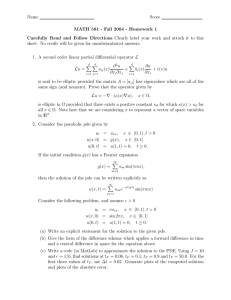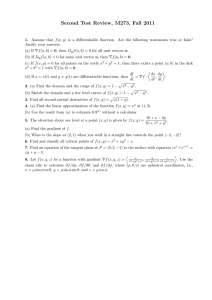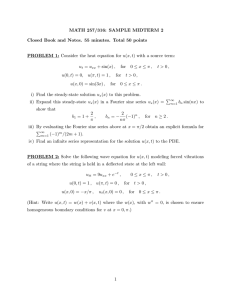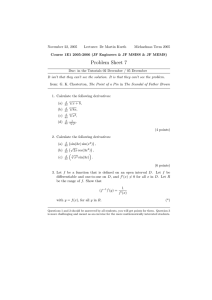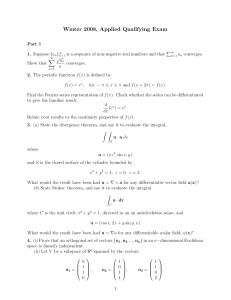MATH 425, HOMEWORK 1, SOLUTIONS Exercise 1. We recall from
advertisement
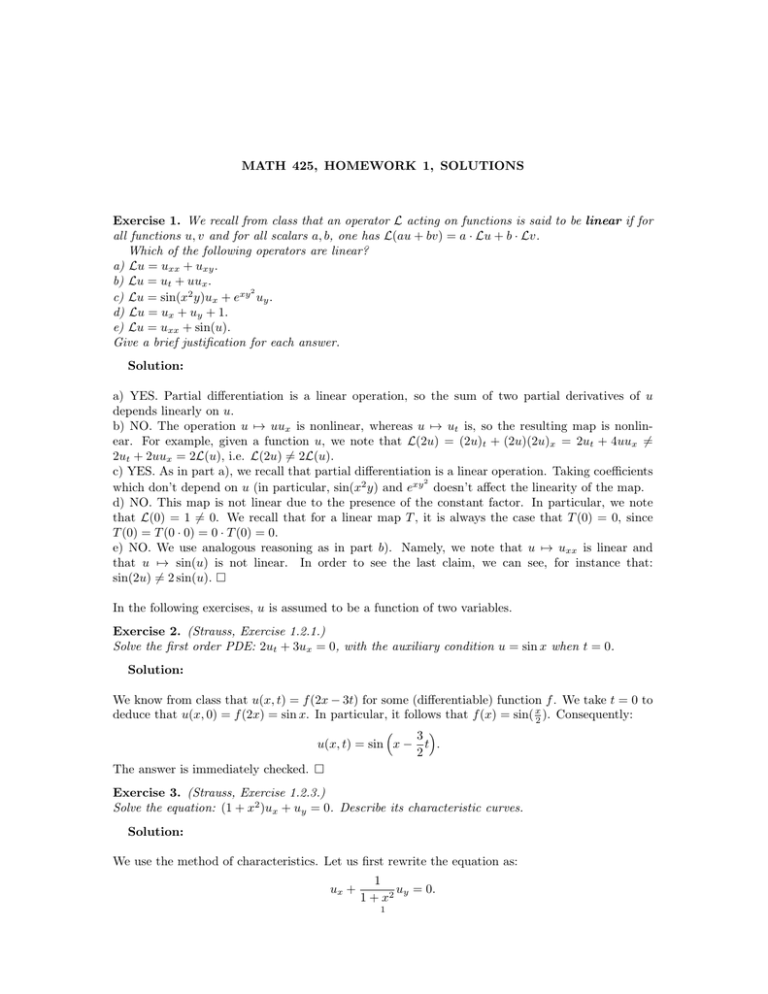
MATH 425, HOMEWORK 1, SOLUTIONS Exercise 1. We recall from class that an operator L acting on functions is said to be linear if for all functions u, v and for all scalars a, b, one has L(au + bv) = a · Lu + b · Lv. Which of the following operators are linear? a) Lu = uxx + uxy . b) Lu = ut + uux . 2 c) Lu = sin(x2 y)ux + exy uy . d) Lu = ux + uy + 1. e) Lu = uxx + sin(u). Give a brief justification for each answer. Solution: a) YES. Partial differentiation is a linear operation, so the sum of two partial derivatives of u depends linearly on u. b) NO. The operation u 7→ uux is nonlinear, whereas u 7→ ut is, so the resulting map is nonlinear. For example, given a function u, we note that L(2u) = (2u)t + (2u)(2u)x = 2ut + 4uux 6= 2ut + 2uux = 2L(u), i.e. L(2u) 6= 2L(u). c) YES. As in part a), we recall that partial differentiation is a linear operation. Taking coefficients 2 which don’t depend on u (in particular, sin(x2 y) and exy doesn’t affect the linearity of the map. d) NO. This map is not linear due to the presence of the constant factor. In particular, we note that L(0) = 1 6= 0. We recall that for a linear map T , it is always the case that T (0) = 0, since T (0) = T (0 · 0) = 0 · T (0) = 0. e) NO. We use analogous reasoning as in part b). Namely, we note that u 7→ uxx is linear and that u 7→ sin(u) is not linear. In order to see the last claim, we can see, for instance that: sin(2u) 6= 2 sin(u). In the following exercises, u is assumed to be a function of two variables. Exercise 2. (Strauss, Exercise 1.2.1.) Solve the first order PDE: 2ut + 3ux = 0, with the auxiliary condition u = sin x when t = 0. Solution: We know from class that u(x, t) = f (2x − 3t) for some (differentiable) function f . We take t = 0 to deduce that u(x, 0) = f (2x) = sin x. In particular, it follows that f (x) = sin( x2 ). Consequently: 3 u(x, t) = sin x − t . 2 The answer is immediately checked. Exercise 3. (Strauss, Exercise 1.2.3.) Solve the equation: (1 + x2 )ux + uy = 0. Describe its characteristic curves. Solution: We use the method of characteristics. Let us first rewrite the equation as: ux + 1 uy = 0. 1 + x2 1 2 MATH 425, HOMEWORK 1, SOLUTIONS The characteristic ODE then becomes: dy 1 = dx 1 + x2 which, by Separation of Variables can be solved as: y = arctan x + C. for some constant C. It follows that: u(x, y) = f (y − arctan x) for some (differentiable) function f . Again, the answer is immediately checked. Moreover, the characteristic curves are the translates of the graph of the function arctan x. Exercise 4. (Strauss, Exercise 1.2.6.) 2 a) Solve the equation: yux + xuy = 0, with the condition u(0, y) = e−y . b) In which region of the xy-plane is the solution uniquely determined? Solution: a) We will apply the method of characteristics. We rewrite the PDE as: x ux + uy = 0. y One then needs to solve: x dy = . dx y We can separate variables to deduce: x dx = y dy It follows that the characteristic curves are given are given by the connected components of: (1) x2 − y 2 = C. for C ∈ R. Let us first solve the problem in full generality and we later substitute the value of u(0, y) (solving the problem directly also counts for full credit). One has to be a bit careful here; for C 6= 0, equation (1) gives us two segments of a hyperbola (so not one connected curve), and for C = 0, it gives us the union of the lines y = x and y = −x. In any case, by the method of characteristics, the function u will be constant on each of the connected components of these curves. It follows that: C, if y = ±x 2 2 2 2 g1 (x − y ), if x − y < 0 and y > 0 (Upwards facing hyperbolic segments) u(x, y) = g2 (x2 − y 2 ), if x2 − y 2 < 0 and y < 0 (Downwards facing hyperbolic segments) h1 (x2 − y 2 ), if x2 − y 2 > 0 and x > 0 (Rightwards facing hyperbolic segments) h (x2 − y 2 ), if x2 − y 2 > 0 and x < 0 (Leftwards facing hyperbolic segments) 2 Strictly speaking, we must choose the constant C and the functions g1 , g2 , h1 , h2 in such a way that the resulting function u is differentiable. What is important to notice is the fact that the functions g1 and g2 are mutually independent. The same holds for the functions h1 and h2 . 2 Now, we go back to the specific example where u(0, y) = e−y . We note that (0, y0 ) is the intersection of the y axis with the set x2 − y 2 = −y02 in the half-plane where y has the same sign as y0 (if y0 = 0, this point is just (0, 0)). Using this observation, the previous case-by-case formula for u, and the 2 assumption that u(0, y) = e−y , it follows that: g1 (x) = x, g2 (x) = x and C = 1. In particular, we deduce that: 2 2 x −y , if x2 − y 2 ≤ 0. e u(x, y) = h1 (x2 − y 2 ), if x2 − y 2 > 0 and x > 0 (Rightwards facing hyperbolic segments) h2 (x2 − y 2 ), if x2 − y 2 > 0 and x < 0 (Leftwards facing hyperbolic segments) MATH 425, HOMEWORK 1, SOLUTIONS 3 Again, we need to choose the functions h1 and h2 in such a way that the function u is differentiable. b) Since the value of u is given on the y-axis, it follows that the solution is uniquely determined along the characteristic curves which intersect the y-axis. These includes the upwards and downwards facing hyperbolic segments as well as the union of the lines y = x and y = −x. Hence, the solution u is uniquely determined on the set where x2 − y 2 ≤ 0. In our previous notation, this means that we can determine the constant C and the functions g1 and g2 , but the functions h1 and h2 cannot be determined from the given data. It is important to remark that the fact that the functions g1 and g2 are equal in our example is not the case for arbitrary u(0, y). In the specific example it is due to the fact that u(0, y) = u(0, −y), i.e. that the function y 7→ u(0, y) is even. Exercise 5. (Strauss, Exercise 1.2.11.) Use the coordinate method in order to solve the equation: ux + 2uy + (2x − y)u = 2x2 + 3xy − 2y 2 . Solution: Let us take: ( By the Chain Rule, we then obtain: ( ux = ux0 · uy = ux0 · x0 = x + 2y y 0 = 2x − y. ∂x0 ∂x ∂x0 ∂y + uy0 · + uy0 · ∂y 0 ∂x ∂y 0 ∂y = ux0 + 2uy0 = 2ux0 − uy0 . It follows that: ux + 2uy = (ux0 + 2uy0 ) + 2(2ux0 − uy0 ) = 5ux0 . Furthermore, we note that we can factorize the right-hand side of the original PDE (in the (x, y) variables): 2x2 + 3xy − 2y 2 = 2x2 + 4xy − xy − 2y 2 = 2x(x + 2y) − y(x + 2y) = (2x − y) · (x + 2y) = x0 · y 0 . From the preceding, it follows that we can rewrite the PDE in the (x0 , y 0 ) coordinates as: 5ux0 + y 0 u = x0 · y 0 i.e: 1 1 ux0 + y 0 u = x0 · y 0 . 5 5 If we fix y 0 , we can think of the above equation as a first order ODE in x0 . We note that this 1 0 0 equation can then be solved by using the integrating factor given by e 5 x ·y . When we multiply the above PDE with the integrating factor, we obtain: 1 0 0 1 0 0 1 e 5 x ·y u x0 = x0 · y 0 · e 5 x ·y 5 Consequently, Z x0 0 1 0 0 1 1 (2) e 5 x ·y u(x0 , y 0 ) = F (y 0 ) + t · y 0 · e 5 t·y dt. 5 0 for some function F = F (y 0 ). We note that: ( Z x u = a · t, du = adt a · tea·t dt = dv = eat dt, v = a1 eat 0 Z x = xea·x − ea·t dt = 0 4 MATH 425, HOMEWORK 1, SOLUTIONS 1 1 = xea·x − ea·x + . a a We substitute (3) into (2) with a = 15 y 0 to deduce that: (3) 1 0 0 1 0 0 e 5 x ·y u(x0 , y 0 ) = F (y 0 ) + x0 · e 5 x ·y − It follows that: u(x0 , y 0 ) = x0 − 1 0 0 5 5 · e 5 x ·y + 0 0 y y 1 0 0 5 + e− 5 x ·y · f (y 0 ) y0 for the function f (y 0 ) = F (y 0 ) + y50 . Finally, we can change back to the original coordinates (x, y) to deduce that: −2x2 −3xy+2y 2 5 5 u(x, y) = x + 2y − · f (2x − y) +e 2x − y for some function f : R → R.
